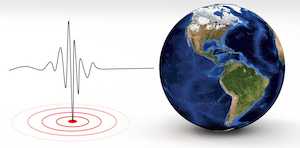The Delhi-NCR has been identified as the second highest seismic hazard zone (Zone IV)
- Posted by Param IAS Team
- Categories Daily News
- Date June 20, 2020
The Delhi-NCR has been identified as the second highest seismic hazard zone (Zone IV)

- In the wake of the recent series of tremors in Delhi-NCR, Wadia Institute of Himalayan Geology, an autonomous institute of the Department of Science and Technology, has said that such tremors are not unusual in the Delhi-NCR region, but indicate that strain energy is built up in the region.
- The Delhi-NCR has been identified as the second highest seismic hazard zone (Zone IV).
- Sometimes, a vulnerable zone remains quiet, experiences small magnitude earthquakes that do not indicate any bigger earthquake, or receives a sudden jolt by a big earthquake without any call.
- Out of 14 small magnitude earthquakes in the Delhi-NCR, the 29th May Rohtak earthquake had the magnitude of 4.6.
- The recent events cannot be defined as the ‘foreshocks’.
- If a big earthquake takes place in a region, all smaller events that occurred in the immediate past at that region are categorised as the foreshocks.
- Therefore, scientifically all these tremors in the Delhi-NCR can be demarcated as the foreshocks only after a big earthquake takes place immediately.
- Though it cannot be predicted, a stronger earthquake posing a threat to people and properties cannot be ruled out.
- Since an earthquake cannot be predicted by any mechanism, the tremors cannot be described as the signal of a big event.
Q. Why earthquakes happen in Delhi-NCR?
All the earthquakes in Delhi-NCR are due to the release of strain energy, which have been accumulated as a result of northward movement of Indian plate and its collision with the Eurasian plate, through the fault or weak zones.
There are so many weak zones and faults in the Delhi-NCR: Delhi-Haridwar ridge, Mahendragarh-Dehradun subsurface fault, Moradabad fault, Sohna fault, Great boundary fault, Delhi-Sargodha ridge, Yamuna river lineament, Ganga river lineament etc.
We must understand that the Himalayan seismic belt, where the Indian plate collided with the Eurasian plate and underthrusted beneath the Himalayan wedge, accumulates strain energy at the plate boundary due to relative movement of plates against each other causing crustal shortening and deformation of rocks.
These energy can be released through the weak zones and faults in the form of earthquakes ranging from micro (<3.0), minor (3.0-3.9), light (4.0-4.9), moderate (5.0-5.9), strong (6.0-6.9), major (7.0-7.9) or great (>8.0) earthquake, defined as per the amount of energy released.
The small magnitude earthquakes are frequent, but large magnitude earthquakes are rare to very rare.
It is the large earthquakes that cause severe damages both to structures and properties.
"Start where you are. Use what you have. Do what you can."
"The secret of success is to do the common things uncommonly well."
"Good things come to people who wait, but better things come to those who go out and get them."
"Success is the sum of small efforts, repeated day in and day out."
Read, Read, and .....Read..
You may also like
Union Budget 2021-22
Union Budget 2021-22 The budget for the year 2021 has been presented amidst exceptional circumstances. Today’s Budget contains a vision of self-reliance as well as inclusiveness for every individual and class. The budget has principles of new opportunities for growth, …
Foster digital literacy and accelerate the India startup ecosystem with Atal Incubation Centers Atal Innovation Mission (AIM), NITI Aayog and SAP Labs India have strengthened their partnership to promote digital literacy, innovation and entrepreneurship in India. As part of the …
Indo-Nepal Link Canal, 260TH ARMY SERVICE CORPS DAY
Indo-Nepal Link Canal India’s premier hydropower company and a PSU under Ministry of Power, laid the foundation stone of head regulator works of Indo-Nepal Link Canal at Barrage of 94.2 MW Tanakpur Power Station of NHPC located in Banbasa, Distt. …
